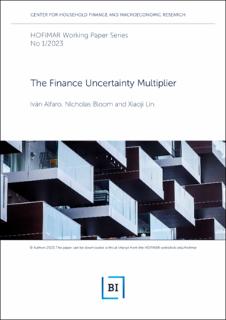| dc.contributor.author | Alfaro, Iván | |
| dc.contributor.author | Bloom, Nicholas | |
| dc.contributor.author | Lin, Xiaoji | |
| dc.date.accessioned | 2024-04-04T10:58:08Z | |
| dc.date.available | 2024-04-04T10:58:08Z | |
| dc.date.issued | 2023 | |
| dc.identifier.issn | 2704-1980 | |
| dc.identifier.uri | https://hdl.handle.net/11250/3124829 | |
| dc.description.abstract | We show how real and financial frictions amplify, prolong and propagate the negative impact of uncertainty shocks. We first use a novel instrumentation strategy to address endogeneity in estimating the impact of uncertainty by exploiting differential firm exposure to exchange rate, policy, and energy price volatility in a panel of US firms. Using common proxies for financial constraints we show that ex-ante financially constrained firms cut their investment even more than unconstrained firms following an uncertainty shock. We then build a general equilibrium heterogeneous firms model with real and financial frictions, finding financial frictions: i) amplify uncertainty shocks by doubling their impact on output; ii) increase persistence by extending the duration of the drop by 50%; and iii) propagate uncertainty shocks by spreading their impact onto financial variables. These results highlight why in periods of greater financial frictions uncertainty can be particularly damaging | en_US |
| dc.language.iso | eng | en_US |
| dc.publisher | BI Norwegian Business School | en_US |
| dc.relation.ispartofseries | HOFIMAR Working Paper Series; 1/2023 | |
| dc.subject | Uncertainty | en_US |
| dc.subject | Financial frictions | en_US |
| dc.subject | Investment | en_US |
| dc.subject | Employment | en_US |
| dc.subject | Cash holding | en_US |
| dc.subject | Equity payouts | en_US |
| dc.title | The Finance Uncertainty Multiplier | en_US |
| dc.type | Working paper | en_US |
| dc.source.pagenumber | 75 | en_US |
